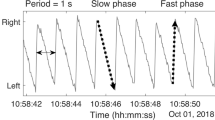Summary
The effects of oral triazolam 0.25 mg and zopiclone 7.5 mg in 7 supine volunteers were compared by means of quantitative measurements of the EEG, saccadic eye movements, visual analogue scale (VAS) for alertness, critical flicker fusion frequency (CFF) and the Maddox wing.
Zopiclone reached its maximum effect earlier (62 min) than triazolam (91 min; CFF). On linear regression analysis the average rate constant (regression coefficient) of onset of action of zopiclone was significantly greater than that of triazolam (0.29 vs. 0.17).
Triazolam and zopiclone had similar effects, but zopiclone seemed to have a faster onset of action, probably indicating swifter absorption in supine subjects.
Quantitative EEG evaluation gave parallel results to the other parameters used, but triazolam and zopiclone showed a dissimilar mechanism of action, as characterized by changes in the alpha frequency.
Similar content being viewed by others
References
Lindsley DB (1960) Attention, consciousness, sleep and wakefulness. In: Field J et al. (eds) Handbook of Physiology. Nagoun HW (section ed). Section 1: Neurophysiology. American Physiological Society, Washington DC
Fink M (1982) Quantitative pharmaco-EEG to establish dose-time relations in clinical pharmacology. In: Herrman WM (ed) Electroencephalography in drug research. Fischer, Stuttgart
Kunkel H (1982) On some hypotheses underlying pharmacoelectroencephalography. In: Herrman WM (ed) Electroencephalography in drug research. Fischer, Stuttgart
Matejcek M (1982) Vigilance and the EEG: Psychological, physiological and pharmacological aspects. In: Herrman WM (ed) Electroencephalography in drug research. Fischer, Stuttgart
Sittig W, Badian M, Rupp W, Taeuber K (1982) Performance tests and pharmaco-EEG after 1,4- and 1,5-benzodiazepines. In: Herrman WM (ed) Electroencephalography in drug research. Fischer, Stuttgart
Aschoff JC (1968) Veränderungen rascher Blickbewegungen (saccaden) beim Menschen unter Diazepam (Valium). Arch Psychiat Nervenkr 211: 325–332
Bittencourt PRM, Wade P, Smith AT, Richens A (1981) The relationship between peak velocity of saccadic eye movements and serum benzodiazepine concentration. Br J Clin Pharmacol (12): 523–533
Hofferberth B (1986) Saccadic eye movements as a measure of residual effects: temazepam compared with other hypnotics. Acta Psychiatr Scand [Suppl] 74: 105–111
Salonen M, Aantaa E, Aaltonen L, Kanto J (1986) Importance of the interaction of midazolam and cimetidine. Acta Pharmacol Toxicol 58: 91–95
Friedman H, Greenblatt DJ, Burstein ES, Harmatz JS, Shader RI (1986) Population study of triazolam pharmacokinetics. Br J Clin Pharmacol 22: 639–642
Thomas D, Tipping T, Halifax R, Blogg CE, Hollands MA (1986) Triazolam premedication. Anaesthesia 41: 692–697
Goa KL, Heel RC (1986) Zopiclone. A review of its pharmacodynamic and pharmacokinetic properties and therapeutic efficacy as an hypnotic. Drugs 32: 48–65
Houghton G, Dennis M, Templeton R, Martin B (1985) A repeated dose pharmacokinetic study of a new hypnotic agent, zopiclone (Imovane®). Int J Clin Pharmacol Ther Toxicol (23): 97–100
Autret E, Maillard F, Autret A (1987) Comparison of the clinical hypnotic effects of zopiclone and triazolam. Eur J Clin Pharmacol 31: 621–623
Warot D, Bensimon G, Danjou Ph, Puech AJ (1987) Comparative effects of zopiclone, triazolam and placebo on memory and psychomotor performance in healthy volunteers. Fund Clin Pharmacol 1: 145–152
Smith RB, Kroboth PD, Phillips JP (1986) Temporal variation in triazolam pharmacokinetics and pharmacodynamics after oral administration. J Clin Pharmacol 26: 120–124
Bond A, Lader M (1974) The use of analogue scales in rating subjective feelings. Br J Med Psychol 47: 211–218
Maxwell C (1978) Sensitivity and accuracy of the visual analogue scale: a psycho-physical classroom experiment. Br J Clin Pharmacol 6: 15–24
Smith JM, Misiak H (1976) Critical flicker frequency (CFF) and psychotropic drugs in normal human subjects — a review. Psychopharmacol (47): 175–182
Hannington-Kiff JG (1970) Measurement of recovery from outpatient general anaesthesia with a simple ocular test. Br Med J 3: 132–135
Blanchard JC, Boireau A, Garret C (1984) Binding properties of zopiclone. Nord Psykiatr Tidsskr 10 [Suppl]: 21–27
Julou L, Blanchard JC, Dreyfus JF (1985) Pharmacological and clinical studies of cyclopyrrolones: Zopiclone and suriclone. Pharmacol Biochem Behav 23: 653–659
Smith RB, Kroboth PD, Varner PD (1987) Pharmacodynamics of triazolam after intravenous administration. J Clin Pharmacol 27: 971–979
Author information
Authors and Affiliations
Rights and permissions
About this article
Cite this article
Aantaa, R., Salonen, M. & Nyrke, T. Difference in action between oral triazolam and zopiclone. Eur J Clin Pharmacol 38, 47–51 (1990). https://doi.org/10.1007/BF00314802
Received:
Accepted:
Issue Date:
DOI: https://doi.org/10.1007/BF00314802




